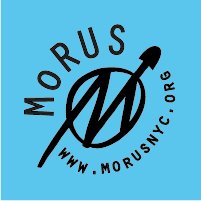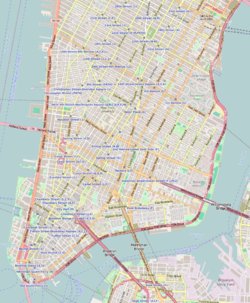 | |
 A French marching band in front of MoRUS A French marching band in front of MoRUS | |
 | |
| Established | 2012 (2012) |
|---|---|
| Location | 155 Avenue C, Manhattan, New York 10009 |
| Coordinates | 40°43′32.78″N 73°58′40.68″W / 40.7257722°N 73.9779667°W / 40.7257722; -73.9779667 |
| Website | morusnyc |
The Museum of Reclaimed Urban Space (MoRUS) is a not-for profit museum founded by the Times Up! Environmental Organization in 2012. It is dedicated to archiving the history of community gardens, squatting, and grassroots environmental activism of the Lower East Side neighborhood of Manhattan, New York City. Located in the storefront of C-Squat at 155 Avenue C, the museum documents how neighborhood residents transformed abandoned spaces and lots in the neighborhood into squats and gardens. By preserving the neighborhood's history, the museum aims to educate communities and individuals to keep this form of sustainable, community-based activism alive.
Background
During the 1970s recession, New York City cut back social services in many neighborhoods, which particularly affected the Lower East Side. Many landlords vacated their buildings, despite people still living in them, which lead to a large-scale diaspora from the neighborhood. The neighborhood was home to many artists, musicians, and activists. Residents actively resisted disinvestment on the part of the city and landlords, and instead of moving out, reclaimed these spaces. They repaired abandoned buildings, transforming them into communal living spaces such as homesteads, squats, and community centers. In these spaces the new residents held collective meetings, skill-shares, and workdays to manage these spaces, while vacant lots were transformed into community gardens that served as gathering places.
The Museum of Reclaimed Urban Space was founded by Bill Di Paola and Laurie Mittelmann to preserve the history of New York City's Lower East Side and promote the local communities that came together in order to make the neighborhood a cultural icon on New York City.
Museum
The museum is located in the storefront of C-Squat, one of the few still-occupied squats on the Lower East Side. The museum is "decidedly local", run by local volunteers, and presents the neighborhood's history through a combination of exhibitions, walking tours, and events. Permanent exhibitions explore various themes aspects of the neighborhood's radical history, including sustainability, activist spaces, and the Occupy Wall Street movement. Rotating exhibitions have covered 1980s political street posters and stencils and the community garden movement; a current exhibition documents the punk movement and its politics. The educational walking tours lead participants through neighborhood squats and community gardens, describing complex histories and struggles with developers and police over the control of urban space in the East Village. The tour guides are neighborhood activists and historians. The museum claims that these activities and exhibitions "seeks to connect the neighborhood's history of activism with the principle of sustainability". In 2020, the museum self-published a book, History of the East Village & Museum of Reclaimed Urban Space, which catalogs the history of MoRUS and that of the East Village.
-
 An event in the Museum's lobby.
An event in the Museum's lobby.
-
 Volunteers work to preserve and protect the history of their neighborhood through archival work.
Volunteers work to preserve and protect the history of their neighborhood through archival work.
Further reading
- Leland, John (December 8, 2012). "The Museum of Reclaimed Urban Space Enshrines the East Village Struggle". The New York Times. ISSN 0362-4331. Retrieved January 26, 2019.
- Malsin, Jared. "Sitting Down to Talk Squatting With Homesteading Museum Founders". The Local. Retrieved January 26, 2019.
- McArdle, Andrea (2015). "Re-integrating Community Space: The Legal and Social Meanings of Reclaiming Abandoned Space in New York's Lower East Side". Savannah Law Review. 2 (1): 247–264. Retrieved January 25, 2019 – via CUNY Academic Works.
- Moynihan, Colin (March 4, 2012). "East Village Museum Shares a Piece of Activist History". The New York Times. ISSN 0362-4331. Retrieved January 26, 2019.
- Moynihan, Colin (May 18, 2017). "When Posters Were the Samizdat of the Lower East Side". The New York Times. ISSN 0362-4331. Retrieved January 26, 2019.
- Steinhauer, Jillian (2013). "Building a Museum of Activism". Hyperallergic. Retrieved January 25, 2019.
- Museum of Reclaimed Urban Space (2020). "History of the East Village & Museum of Reclaimed Urban Space". Issuu. Retrieved June 4, 2021.
- Abdallah, Yasmeen (May 5, 2021). "Rethinking museums: The Museum of Reclaimed Urban Space". Urban Activist. Retrieved June 4, 2021.
References
- ^ McArdle, Andrea (2015). "Re-integrating Community Space: The Legal and Social Meanings of Reclaiming Abandoned Space in New York's Lower East Side". Savannah Law Review. 2 (1): 247–264 – via CUNY Academic Works.
- Luna, Cari (2014). "Squatters of the Lower East Side". Jacobin. Retrieved January 25, 2019.
- Moynihan, Colin (March 4, 2012). "East Village Museum Shares a Piece of Activist History". The New York Times. ISSN 0362-4331. Retrieved January 26, 2019.
- Steinhauer, Jillian (2013). "Building a Museum of Activism". Hyperallergic. Retrieved January 25, 2019.
- Malsin, Jared. "Sitting Down to Talk Squatting With Homesteading Museum Founders". The Local. Retrieved January 26, 2019.
- Museum of Reclaimed Urban Space. "History of the East Village & Museum of Reclaimed Urban Space". Issuu. Retrieved June 4, 2021.
External links
![]() Media related to Museum of Reclaimed Urban Space at Wikimedia Commons
Media related to Museum of Reclaimed Urban Space at Wikimedia Commons
| Housing rights in New York | |||||
|---|---|---|---|---|---|
| Government agencies | |||||
| Legislation |
| ||||
| Non-/ governmental organizations |
| ||||
| Squatting and homesteading | |||||
| Housing rights activists | |||||
| Media | |||||
| Events | |||||
| See also | |||||